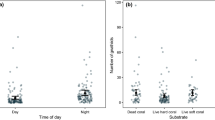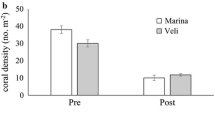Abstract
Population outbreaks of corallivorous Drupella gastropods have caused mass coral mortality, but there is insufficient information on their feeding behaviour to develop useful reef management strategies. This study examined the feeding rates of two Drupella species, D. rugosa (Born 1778) and D. margariticola (Broderip 1833), and investigated whether the presence of the coral guard crab, Trapezia cymodoce (Herbst 1801), could help to reduce corallivory on Pocillopora acuta (Lamarck 1816). Our mesocosm study showed that the feeding rate of D. rugosa (1.81 ± 0.95 cm2 coral tissue/day) was significantly higher than that of D. margariticola (0.51 ± 0.75 cm2 coral tissue/day). The presence of T. cymodoce reduced the feeding rate of D. rugosa by 22.9%; this was lower than that by other Trapezia congenerics. Trapezia cymodoce also did not display much aggressive behaviour towards D. rugosa. This study has highlighted that D. rugosa can cause considerable damage to corals and defence by T. cymodoce alone is unlikely to be effective against Drupella corallivory. Early detection of Drupella outbreaks and the subsequent development of mitigation measures remain of paramount importance in reducing the impact of corallivory on coral reefs.


Similar content being viewed by others
References
Afiq-Rosli L, Taira D, Loke HX et al (2017) In situ nurseries enhance coral transplant growth in sedimented waters. J Mar Biol Res 26:1–10
Al-Horani FA, Hamdi M, Al-Rousan SA (2011) Prey selection and feeding rates of Drupella cornus (Gastropoda: Muricidae) on corals from the Jordanian coast of the Gulf of Aqaba, Red Sea. J Biol Sci 4:191–198
Awakuni T (1989) Reproduction and growth of coral predators, Drupella Fraga and Drupella Cornus (Gastropoda: Muricidae), Honours thesis. University of Ryukus, Japan
Ayling AM, Ayling AL (1987) Ningaloo Marine Park: preliminary fish density assessment and habitat survey, with information on coral damage due to Drupella cornus grazing. A report prepared for the Department of Conservation and Land Management, Western Australia. Department of Conservation and Land Management
Baird A (1999) A large aggregation of Drupella rugosa following the mass bleaching of corals on the Great Barrier Reef. Reef Res 9:6–7
Baker AC, Glynn PW, Riegl B (2008) Climate change and coral reef bleaching: an ecological assessment of long-term impacts, recovery trends and future outlook. Estuar Coast Mar Sci 80:435–471
Boucher LM (1986) Coral predation by muricid gastropods of the genus Drupella at Enewetak, Marshall Islands. Bull Mar Sci 38:9–11
Bruckner AW, Coward G, Bimson K, Rattanawongwan T (2017) Predation by feeding aggregations of Drupella spp. inhibits the recovery of reefs damaged by a mass bleaching event. Coral Reefs 36(4):1181–1187
Castro P (1978) Movements between coral colonies in Trapezia ferruginea (Crustacea: Brachyura), an obligate symbiont of scleractinian corals. Mar Biol 46(3):237–245
Castro P (1997a) Trapeziid crabs (Brachyura: Xanthoidea: Trapeziidae) of New Caledonia, eastern Australia, and the Coral Sea. Les fonds meubles des lagons de Nouvelle-Calédonie (Sédimentologie, Benthos). Études et Thèses 3:59–107
Castro P (1997b) Trapeziid crabs (Brachyura: Xanthoidea: Trapeziidae) of French Polynesia. Le benthos des fonds meubles des lagons de Nouvelle-Calédonie (Sédimentologie, Benthos). Études Thèses 3:109–139
Claremont M, Reid DG, Williams ST (2011) Evolution of corallivory in the gastropod genus Drupella. Coral Reefs 30:977–990
Cumming RL (1999) Predation on reef-building corals: multiscale variation in the density of three corallivorous gastropods, Drupella spp. Coral Reefs 18:147–157
Cumming RL (2009) Population outbreaks and large aggregations of Drupella on the Great Barrier Reef, vol 96, pp 1–44. Report to the Great Barrier Reef Marine Park Authority, Townsville
Cumming RL, McCorry D (1998) Corallivorous gastropods in Hong Kong. Coral Reefs 17:178
Fujioka Y (1982) On the secondary sexual characters found in the dimorphic radula of Drupella (Gastropoda: Muricidae) with reference to its taxonomic revision. Venus 40:203–223
Fujioka Y (1985) Seasonal aberrant radular formation in Thais bronni (Dunker) and T. clavigera (Küster) (Gastropoda: Muricidae). J Exp Mar Biol Ecol 90:43–54
Fujioka Y, Yamazato K (1983) Host selection of some Okinawan coral associated gastropods belonging to the genera Drupella, Coralliophila and Quoyula. Galaxea 2:59–73
Glynn PW (1980) Defense by symbiotic crustacea of host corals elicited by chemical cues from predator. Oecologia 47:287–290
Glynn PW (2013) Fine-scale interspecific interactions on coral reefs: functional roles of small and cryptic metazoans. Smithson Contrib Mar Sci 39:229–248
Gokul A, Venkataraman K (2010) Taxonomy and systematics of coral associated Brachyuran crabs in Gulf of Mannar marine biosphere reserve. Rec Zool Surv India 110:61–76
Hoeksema BW, Scott C, True JD (2013) Dietary shift in corallivorous Drupella snails following a major bleaching event at Koh Tao, Gulf of Thailand. Coral Reefs 32:423–428
Ishida S (2001) An analysis of feeding aggregations in intertidal muricids: species- specific modes of foraging—initial predation and parasitism. Asian Mar Biol 18:1–13
Kita M, Kitamura M, Koyama T, Teruya T, Matsumoto H, Nakano Y, Uemura D (2005) Feeding attractants for the muricid gastropod Drupella cornus, a coral predator. Tetrahedron Lett 46:8583–8585
McKeon CS, Moore JM (2014) Species and size diversity in protective services offered by coral guard-crabs. PeerJ 2:e574
McKeon CS, Stier AC, McIlroy SE, Bolker BM (2012) Multiple defender effects: synergistic coral defence by mutualist crustaceans. Oecologia 169:1095–1103
Moerland MS, Scott CM, Hoeksema BW (2016) Prey selection of corallivorous muricids at Koh Tao (Gulf of Thailand) four years after a major coral bleaching event. Contrib Zool 85:291–309
Morton B, Blackmore G (2009) Seasonal variations in the density of and corallivory by Drupella rugosa and Cronia margariticola (Caenogastropoda: Muricidae) from the coastal waters of Hong Kong: ‘plagues’ or ‘aggregations’? J Mar Biol Assoc UK 89:147–159
Morton B, Blackmore G, Kwok CT (2002) Corallivory and prey choice by Drupella rugosa (Gastropoda: Muricidae) in Hong Kong. J Molluscan Stud 68:217–223
Moyer JT, Emerson WK, Ross M (1982) Massive destruction of scleractinian corals by the muricid gastropod, Drupella in Japan and the Philippines. Nautilus 96:69–82
Rotjan RD, Lewis SM (2008) Impact of coral predators on tropical reefs. Mar Ecol Prog Ser 367:73–91
Sam SQ, Kikuzawa YP, Taira D, Ng CSL, Toh TC, Chou LM (2016) First observation of Drupella rugosa egg capsules on scleractinian coral Pocillopora damicornis. Bull Mar Sci 92:353–354
Sam SQ, Toh TC, Kikuzawa YP et al (2017) Egg capsules and veligers of the corallivorous muricid gastropod Drupella rugosa (Born, 1778). Invertebr Reprod Dev 61(3):164–171
Schoepf V, Herler J, Zuschin M (2010) Microhabitat use and prey selection of the coral-feeding snail Drupella cornus in the northern Red Sea. Hydrobiologia 641:45–57
Scott CM, Mehrotra R, Hoeksema BW (2017a) In-situ egg deposition by corallivorous snails on mushroom corals at Koh Tao (Gulf of Thailand). J Molluscan Stud 83(3):360–362
Scott CM, Mehrotra R, Hein MY, Moerland MS, Hoeksema BW (2017b) Population dynamics of corallivores (Drupella and Acanthaster) on coral reefs of Koh Tao, a diving destination in the Gulf of Thailand. Raffles Bull Zool 65:68–79
Shafir S, Van Rijn J, Rinkevich B (2006) Steps in the construction of underwater coral nursery, an essential component in reef restoration acts. Mar Biol 149:679–687
Shafir S, Gur O, Rinkevich B (2008) A Drupella cornus outbreak in the northern Gulf of Eilat and changes in coral prey. Coral Reefs 27:379
Sin TM, Lee AC (2000) Host specialisation in trapeziid crabs: consequences for rarity at local scales. In: Proc 9th int coral reef symp, vol 1, pp 533–536
Stier AC, McKeon CS, Osenberg CW, Shima JS (2010) Guard crabs alleviate deleterious effects of vermetid snails on a branching coral. Coral Reefs 29:1019–1022
Stimson J (1990) Stimulation of fat-body production in the polyps of the coral Pocillopora damicornis by the presence of mutualistic crabs of the genus Trapezia. Mar Biol 106:211–218
Stoddart JA (1989) Fatal attraction. Landscope 4:14–20
Toh TC, Ng CSL, Loke HX, Taira D, Toh KB, Afiq-Rosli L, Du RC, Cabaitan P, Sam SQ, Kikuzawa YP, Chou LM (2017) A cost-effective approach to enhance scleractinian diversity on artificial shorelines. Ecol Eng 99:349–357
Tsang RHL, Ang P Jr (2015) Cold temperature stress and predation effects on corals: their possible roles in structuring a nonreefal coral community. Coral Reefs 34:97–108
Turner S (1992) Drupella cornus: a synopsis. CALM Occas Pap 3:92
Turner SJ (1994) Spatial variability in the abundance of the corallivorous gastropod Drupella cornus. Coral Reefs 13:41–48
Vogler C, Benzie J, Lessios H, Barber P, Wörheide G (2008) A threat to coral reefs multiplied? Four species of crown-of-thorns starfish. Biol Lett 4:696–699
Williams ST, Knowlton N, Weigt LA, Jara JA (2001) Evidence for three major clades within the snapping shrimp genus Alpheus inferred from nuclear and mitochondrial gene sequence data. Mol Phylogenet Evol 20:375–389
Acknowledgements
We would like to thank the staff of Tropical Marine Science Institute and St John’s Island National Marine Laboratory for their logistical and administrative support. We appreciate the inputs by the editor and reviewers to improve the manuscript. This study is part of the project “Enhancing Singapore’s coral reef ecosystem in a green port” funded by the Maritime and Port Authority of Singapore [R-347-001-215-490].
Funding
This study was funded by the Maritime and Port Authority of Singapore [R-347-001-215-490].
Author information
Authors and Affiliations
Corresponding author
Ethics declarations
Ethical approval
All applicable international, national, and/or institutional guidelines for the care and use of animals were followed. Permits were obtained prior to conducting the research.
Conflict of interest
All authors declare that they have no conflict of interest.
Additional information
Responsible Editor: F. Bulleri.
Reviewed by B. Morton and an undisclosed expert.
Rights and permissions
About this article
Cite this article
Samsuri, A.N., Kikuzawa, Y.P., Taira, D. et al. The effectiveness of Trapezia cymodoce in defending its host coral Pocillopora acuta against corallivorous Drupella. Mar Biol 165, 70 (2018). https://doi.org/10.1007/s00227-018-3330-2
Received:
Accepted:
Published:
DOI: https://doi.org/10.1007/s00227-018-3330-2




